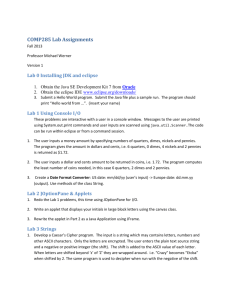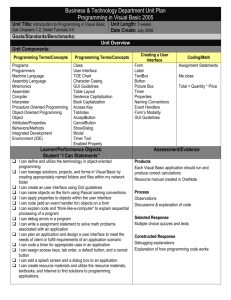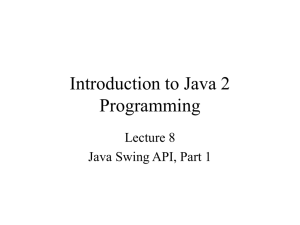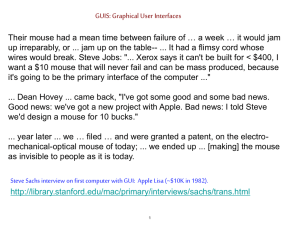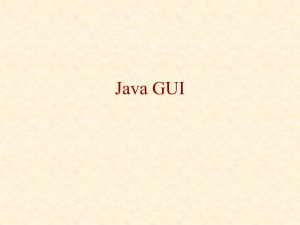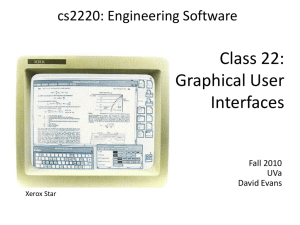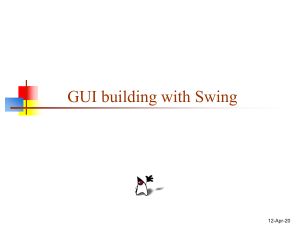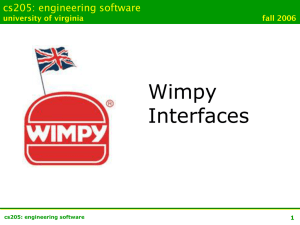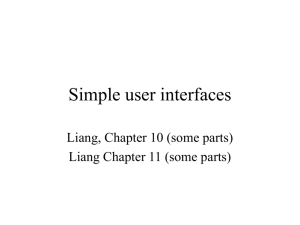CSE 331 Lecture Slides
advertisement
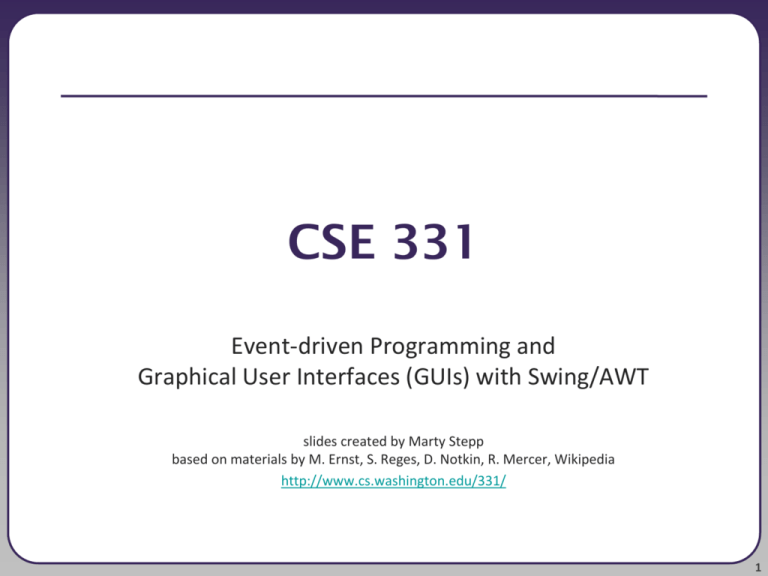
CSE 331
Event-driven Programming and
Graphical User Interfaces (GUIs) with Swing/AWT
slides created by Marty Stepp
based on materials by M. Ernst, S. Reges, D. Notkin, R. Mercer, Wikipedia
http://www.cs.washington.edu/331/
1
Why learn GUIs?
• Learn about event-driven programming techniques
• Practice learning and using a large, complex API
• A chance to see how it is designed and learn from it:
model-view separation
design patterns
refactoring vs. reimplementing an ailing API
• Because GUIs are neat!
• Caution: There is way more here than you can memorize.
Part of learning a large API is "letting go."
You won't memorize it all; you will look things up as you need them.
But you can learn the fundamental concepts and general ideas.
2
Java GUI History
• Abstract Windowing Toolkit (AWT): Sun's initial effort to create a
set of cross-platform GUI classes. (JDK 1.0 - 1.1)
Maps general Java code to each operating system's real GUI system.
Problems: Limited to lowest common denominator; clunky to use.
• Swing: A newer GUI library written from the ground up that allows
much more powerful graphics and GUI construction. (JDK 1.2+)
Paints GUI controls itself pixel-by-pixel rather than handing off to OS.
Benefits: Features; compatibility; OO design.
Problem: Both exist in Java now; easy to get them
mixed up; still have to use both in various places.
3
GUI terminology
• window: A first-class citizen of the graphical desktop.
Also called a top-level container.
examples: frame, dialog box, applet
• component: A GUI widget that resides in a window.
Also called controls in many other languages.
examples: button, text box, label
• container: A logical grouping for storing components.
examples: panel, box
4
Components
5
Swing inheritance hierarchy
• Component
(AWT)
Window
•Frame
•JFrame (Swing)
•JDialog
import java.awt.*;
import javax.swing.*;
Container
•JComponent (Swing)
•JButton
JColorChooser
•JComboBox
JLabel
•JMenuBar
JOptionPane
•JPopupMenu
JProgressBar
•JScrollPane
JSlider
•JSplitPane
JTabbedPane
•JToolbar
JTree
•JTextField
...
JFileChooser
JList
JPanel
JScrollbar
JSpinner
JTable
JTextArea
6
Component properties
Each has a get (or is) accessor and a set modifier method.
examples: getColor, setFont, setEnabled, isVisible
name
background
border
enabled
type
Color
Border
boolean
description
background color behind component
border line around component
whether it can be interacted with
focusable
boolean
whether key text can be typed on it
font
foreground
height, width
visible
tooltip text
Font
Color
int
boolean
String
Dimension
font used for text in component
foreground color of component
component's current size in pixels
whether component can be seen
text shown when hovering mouse
various sizes, size limits, or desired
sizes that the component may take
size, minimum / maximum
/ preferred size
7
JFrame
a graphical window to hold other components
• public JFrame()
public JFrame(String title)
Creates a frame with an optional title.
Call setVisible(true) to make a frame appear on the screen
after creating it.
• public void add(Component comp)
Places the given component or container inside the frame.
8
More JFrame
• public void setDefaultCloseOperation(int op)
Makes the frame perform the given action when it closes.
Common value passed: JFrame.EXIT_ON_CLOSE
If not set, the program will never exit even if the frame is closed.
• public void setSize(int width, int height)
Gives the frame a fixed size in pixels.
• public void pack()
Resizes the frame to fit the components inside it snugly.
9
JButton
a clickable region for causing actions to occur
• public JButton(String text)
Creates a new button with the given string as its text.
• public String getText()
Returns the text showing on the button.
• public void setText(String text)
Sets button's text to be the given string.
10
GUI example
import java.awt.*;
import javax.swing.*;
// Where is the other button?
public class GuiExample1 {
public static void main(String[] args) {
JFrame frame = new JFrame();
frame.setDefaultCloseOperation(JFrame.EXIT_ON_CLOSE);
frame.setSize(new Dimension(300, 100));
frame.setTitle("A frame");
JButton button1 = new JButton();
button1.setText("I'm a button.");
button1.setBackground(Color.BLUE);
frame.add(button1);
JButton button2 = new JButton();
button2.setText("Click me!");
button2.setBackground(Color.RED);
frame.add(button2);
frame.setVisible(true);
}
}
11
Sizing and positioning
How does the programmer specify where each component appears,
how big each component should be, and what the component
should do if the window is resized / moved / maximized / etc.?
• Absolute positioning (C++, C#, others):
Programmer specifies exact pixel coordinates of every component.
"Put this button at (x=15, y=75) and make it 70x31 px in size."
• Layout managers (Java):
Objects that decide where to position each component based on
some general rules or criteria.
"Put these four buttons into a 2x2 grid and put these text boxes in a
horizontal flow in the south part of the frame."
12
Containers and layout
• Place components in a container; add the container to a frame.
container: An object that stores components and governs their
positions, sizes, and resizing behavior.
13
JFrame as container
A JFrame is a container. Containers have these methods:
• public void add(Component comp)
public void add(Component comp, Object info)
Adds a component to the container, possibly giving extra
information about where to place it.
• public void remove(Component comp)
• public void setLayout(LayoutManager mgr)
Uses the given layout manager to position components.
• public void validate()
Refreshes the layout (if it changes after the container is onscreen).
14
Preferred sizes
• Swing component objects each have a certain size they would "like"
to be: Just large enough to fit their contents (text, icons, etc.).
This is called the preferred size of the component.
Some types of layout managers (e.g. FlowLayout) choose to size the
components inside them to the preferred size.
Others (e.g. BorderLayout, GridLayout) disregard the preferred
size and use some other scheme to size the components.
Buttons at preferred size:
Not preferred size:
15
FlowLayout
public FlowLayout()
• treats container as a left-to-right, top-to-bottom "paragraph".
Components are given preferred size, horizontally and vertically.
Components are positioned in the order added.
If too long, components wrap around to the next line.
myFrame.setLayout(new FlowLayout());
myFrame.add(new JButton("Button 1"));
The default layout for containers other than JFrame (seen later).
16
BorderLayout
public BorderLayout()
• Divides container into five regions:
NORTH and SOUTH regions expand to fill region horizontally,
and use the component's preferred size vertically.
WEST and EAST regions expand to fill region vertically,
and use the component's preferred size horizontally.
CENTER uses all space not occupied by others.
myFrame.setLayout(new BorderLayout());
myFrame.add(new JButton("Button 1"), BorderLayout.NORTH);
This is the default layout for a JFrame.
17
GridLayout
public GridLayout(int rows, int columns)
• Treats container as a grid of equally-sized rows and columns.
• Components are given equal horizontal / vertical size, disregarding
preferred size.
• Can specify 0 rows or columns to indicate expansion in that
direction as needed.
18
Event Listeners
19
Graphical events
• event: An object that represents a user's interaction with a GUI
component; can be "handled" to create interactive components.
• listener: An object that waits for events and responds to them.
To handle an event, attach a listener to a component.
The listener will be notified when the event occurs (e.g. button click).
20
Event-driven programming
• event-driven programming: A style of coding where a program's
overall flow of execution is dictated by events.
Rather than a central "main" method that drives execution,
the program loads and waits for user input events.
As each event occurs, the program runs particular code to respond.
The overall flow of what code is executed is determined by the series
of events that occur, not a pre-determined order.
21
Event hierarchy
import java.awt.event.*;
• EventObject
AWTEvent (AWT)
•ActionEvent
•TextEvent
•ComponentEvent
FocusEvent
WindowEvent
InputEvent
• KeyEvent
• MouseEvent
• EventListener
AWTEventListener
ActionListener
TextListener
ComponentListener
FocusListener
WindowListener
KeyListener
MouseListener
22
Action events
• action event: An action that has occurred on a GUI component.
The most common, general event type in Swing. Caused by:
•button or menu clicks,
•check box checking / unchecking,
•pressing Enter in a text field, ...
Represented by a class named ActionEvent
Handled by objects that implement interface ActionListener
23
Implementing a listener
public class name implements ActionListener {
public void actionPerformed(ActionEvent event) {
code to handle the event;
}
}
• JButton and other graphical components have this method:
public void addActionListener(ActionListener al)
Attaches the given listener to be notified of clicks and events that
occur on this component.
24
Nested classes
• nested class: A class defined inside of another class.
• Usefulness:
Nested classes are hidden from other classes (encapsulated).
Nested objects can access/modify the fields of their outer object.
• Event listeners are often defined as nested classes inside a GUI.
25
Nested class syntax
// enclosing outer class
public class name {
...
// nested inner class
private class name {
...
}
}
Only the outer class can see the nested class or make objects of it.
Each nested object is associated with the outer object that created it,
so it can access/modify that outer object's methods/fields.
• If necessary, can refer to outer object as OuterClassName.this
26
Static inner classes
// enclosing outer class
public class name {
...
// non-nested static inner class
public static class name {
...
}
}
Static inner classes are not associated with a particular outer object.
They cannot see the fields of the enclosing class.
Usefulness: Clients can refer to and instantiate static inner classes:
Outer.Inner name = new Outer.Inner(params);
27
GUI event example
public class MyGUI {
private JFrame frame;
private JButton stutter;
private JTextField textfield;
public MyGUI() {
...
stutter.addActionListener(new StutterListener());
}
...
// When button is clicked, doubles the field's text.
private class StutterListener implements ActionListener {
public void actionPerformed(ActionEvent event) {
String text = textfield.getText();
textfield.setText(text + text);
}
}
}
28

